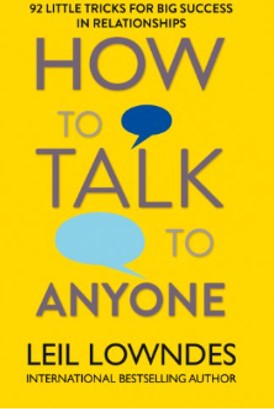
I’m often asked to provide training in conversation skills. Whether it’s for confident or commercial conversations as part of the networking skills toolkit or part of relationship building or sales conversations. I often wonder whether the perceived conversation skills gap was caused by the imposed isolation during the Covid lockdowns or a by-product of the digitisation of communications. People also ask if there are any books to supplement people’s learning – or for those who want a deeper dive into the topic. So I’ve selected three – depending on whether you are a beginner or a pro and whether you are in the UK or the USA. So here is Conversation skills book review 2 – How to talk to anyone – 92 little tricks for big success by Leil Lowndes (1999, 2017) for intermediates. Others in the series:
- Conversation skills book review 1 – How to talk to anyone about anything – James W. Williams (2021) Conversation skills book review (kimtasso.com) Beginners
- Conversation skills book review 3 – Conversational intelligence – how great leaders build trust and get extraordinary results by Judith E Glaser (2014) Conversation skills book review 3: Conversational intelligence (kimtasso.com) Advanced
How to talk to anyone – 92 little tricks for big success by Leil Lowndes (1999, 2017)
The American author Leil Lowndes Author | Leil Lowndes Speaker | Leil Lowndes Motivational Speaker | Leil Lowndes Corporate Trainer | Leil Lowndes Books | Fearless Conversation | How to talk to Anybody About Anything | Goodbye to Shy | How To Make Anyone Fall In Love With You – Leil Lowndes is a communications expert who coaches top executives of the Fortune 500.
The 320 pages – addressing the 92 “tricks” – are conveyed with interesting personal anecdotes and illustrative short stories. Helpfully, after each there’s a short summary making it easy to remember and apply the technique.
There’s a nice quote in the introduction “The way you move is your autobiography in motion” – setting the stage for a number of body language insights Non-Verbal Communication (NVC) – the basics (Video) (kimtasso.com).
There are a few tricks that made me cringe. And a few that seem rather out of touch with modern day life. But there are helpful ideas too – many of them based on managing your own and reading others’ body language (NVC) and simple psychology principles. Many are social etiquette basics. I’ve shared some here:
- Don’t flash an immediate smile. Look at their face. Pause. Soak in their personality. Then let a big, warm, responsive smile flood your face and overflow into your eyes. Later there is advice to develop a repertoire of different smiles. (“The highest approach behaviour, 60 per cent, was observed in the condition in which there was smiling”)
- Use “sticky eyes” (maintain eye contact by counting their blinks) and “epoxy eyes” (watch your target even when someone else is talking). Visualise someone you meet as an old friend
- There are several tips to introducing yourself well: Carry something unusual that draws people’s attention, ask people for a few facts about others and then use them as an icebreaker, eavesdrop in, never give a one-sentence response to a question (drop in a couple of engaging facts about your hometown – or about your job – and adapt those facts depending on who you are meeting – business people, politics, educators etc)
- Keep the spotlight on the other person – ask them lots of questions and listen for cues in what they say (and maybe repeat them back) to keep the dialogue moving. Ask them to recount a story to others that they once told you.
- Use “You” rather than “I” (“Therapists calculate inmates of mental institutions say I and me twelves times more often than residents of the outside world”)
- Be a Big Cat by not asking “What do you do?” – a different way is “How do you spend most of your time?”. Similarly, replace one word job title answers (e.g. “I’m a lawyer”) to a benefit statement (e.g. “I help people resolve disputes without having to go to Court”)
- Replace commonly used words with some more interesting alternatives (e.g. from great to splendid, extraordinary, magnificent, remarkable). Avoid cliches – make up your own insightful and memorable phrases
- Avoid a quick “Me too” – wait before revealing things in common
- Always make it a “Thank you” for something – be specific. And always respond to questions and provide empathisers in full sentences
- Regularly participate in new things – that way you’ll learn 80 per cent of the right lingo and insider questions from just one exposure. It will also provide you with a few opening questions when you meet someone who is passionate or expert in the subject
- Do research before attending events – speak to an expert in the field to learn about the hot topics in the sector, read a variety of trade journals and check out the international customs that might be relevant (there’s a tool for comparing national cultures that I recommend at Country comparison tool (hofstede-insights.com)) and use a six-point party checklist:
- Who will be there?
- When should I arrive?
- What should I take with me?
- Why is the party being given?
- Where is the collective mind?
- How am I going to following up?
- Mirror body posture, gestures and echo their use of words and visual, auditory, kinaesthetic preference. What is neuro linguistic programming and how might it be useful to me? (kimtasso.com)
- Prompt visual images – use analogies, metaphors and stories
- Compliments are the most widely used and thoroughly endorsed of all getting-what-you-want techniques (echoing Dale Carnegie’s “Begin with praise” Book review “How to win friends and influence people” by Dale Carnegie (kimtasso.com). There’s also advice to give compliments behind their back by saying something positive about them to a third person. Similarly, mention to them any good feedback you heard about them from others. Another tip is to include comments that presuppose something positive about them. Sociologists report that
- A compliment from a new person is more potent than from someone you already know
- Your compliment has more credibility when given to an unattractive person or an attractive person whose face you’ve never see
- You are taken more seriously if you preface your compliments by some self-effacing remark (but only if your listener perceives you as higher on the totem pole)
- Return compliments swiftly – by thanking people when they say something nice to you
- There are some techniques for the telephone including increase your smiles and turn nods into noises and gestures into words (and increase by 30%) and always identify and greet whoever answers (see the material on gatekeepers Selling Basics – Detectives and DMUs (Video) and recommended books (kimtasso.com))
- Forget what people said, hear what they meant
- Remember minute details of important contact’s lives (The author calls this tracking) and then the first words of the next call or meeting with that person relates to that information
- Watch unconscious signals when you ask a challenging question – people will quickly look to the most senior person for reassurance
- Appear not to notice when someone makes a minor slip or faux pas to be perceived as a senior person
- If someone is interrupted, encourage them to finish their story
- When asking for a favour, let the person know how much it means to you – and if you do a favour for someone else, wait a suitable amount of time before asking them to repay the favour
- Be aware of sacred havens where you should avoid direct approaches or tough conversations – parties which are for pleasantries and good fellowship, over dinner and chance encounters
- If you need information, let the other person have their entire say first. Hear their fact but empathise with their emotions
- Send a buttercup (a complimentary letter) to people’s superior
- When listening to a talk or speech, the most senior people tend to applaud first – so lead in positive reactions
There’s an interesting analysis of how conversations progress:
- Cliches
- Facts
- Feelings and personal questions
- “We” statements
With a suggestion that you create the sensation of intimacy by using the words: We, Us and Our.
At the end there is a compelling series of statements: “Remember, repeating an action makes it a habit. Your habits create your character. And your character is your destiny”.
The book is structured into the following parts:
- You only have ten seconds to show you’re a somebody
- What do I say after I say “Hello”?
- How to talk like the big boys ‘n’ girls
- How to be an insider in any crowd
- Why, we’re just alike!
- The power of praise, the folly of flattery
- Direct dial their hearts
- How to work a party like a politician works a room
- Little tricks of big winners
Some highlights
- Almost very facet of people’s personality is evident from their appearance, their posture and the way they move
- The study showed women who were slower to smile in corporate life were perceived as more credible
- Your posture is your biggest success barometer
- “People don’t care how much you know until they know how much you care…about them” Zig Ziglar
- An Adelphi University study called “Believing another likes or dislikes you: Behaviours making the beliefs come true”
- Fidgeting undermines credibility
- The brighter the individual, the more he or she detests small talk. Small talk is about putting people at ease – you must first match your listener’s mood. Put people at ease by convincing them they are OK and that the two of you are similar
- Studies show that callers perceive people to be brighter and more efficient when they hear an updated message each time they call
- Munching or mingling? Eat before you attend events as people rarely approach those who are eating.
- People instinctively gravitate towards open palms and wrists arranged in a “I have nothing to hide” manner
Related posts
Conversation skills book review (kimtasso.com) How to talk to anyone about anything – James W. Williams (the first in the series – for beginners)
Introduction to networking skills (Video) (kimtasso.com)
Non-Verbal Communication (NVC) – the basics (Video) (kimtasso.com)
Active Listening (Video) (kimtasso.com)
Be more confident and convey confidence – top tips (kimtasso.com)
Book review “How to win friends and influence people” by Dale Carnegie (kimtasso.com)
Building rapport in the digital space (kimtasso.com)
Book review – Great networking by Alisa Grafton (kimtasso.com)
Soft skills – Dealing with difficult conversations (kimtasso.com)
Book review: The psychology of successful women by Shona Rowan (kimtasso.com)
Book review: Digital Body Language – How to build trust by Erica Dhawan (kimtasso.com)
Psychology and business communication: Intro to transactional analysis (kimtasso.com)
Two big guns of communication – face time and reframing (kimtasso.com)
Influence – Cialdini’s six principles of the psychology of persuasion (kimtasso.com)
Book review – Persuasion: The art of influencing people by James Borg (kimtasso.com)









